Types of outdoor activities. "handkerchief - letunochek"
A selection of games for organizing children's walks
"HELLO".
All stand in a circle face to shoulder to shoulder. The driver goes on the outside of the circle and touches one of the players. Leading and playing, which touched, run in different directions on the outer side of the circle. When they meet, they shake hands and say: "Hello!" You can also call your name (it is discussed in terms of the game). Then they run further, trying to take a free place in the circle. He who remains without a place becomes driving.
"TRAFFIC LIGHT".
At the site it is necessary to draw two lines at a distance of 5 - 6 meters from each other. The players are behind the same line. The driver stands between the lines approximately in the middle with his back to the players. He calls some color. If the players have this color in their clothes, they pass by the driver without hindrance. If the player does not have such a color, then the driver may besigher the runner player. Salted becomes driving.
"PATH".
The participants of the game line up one after another. The one who stands first in this chain becomes leading. All go snake on the path to the back of the head one after another, and the driver overcomes various obstacles. At the signal of the driver, the first player becomes at the end of the snake, and the driver who becomes the first player becomes the driver.
"ENCLOSED LOCK".
The players are divided into two teams. The first is to spell "the castle", and the second is to prevent her from doing so. "Lock" can be a wall or a tree. Near the "castle" are the "main gate" - the guys from the second team are blindfolded. Players who must spell "lock" begin to move around the court on the team leading to the main gate. Their task is to reach the gate unnoticed, walk through them and touch the “castle”. In this game is considered to be over. But the task of the second team is to pester those who are moving to the “castle”. Those who are besieged are eliminated from the game. At the end of the game, teams change roles.
"NEST".
Children squat in a circle, holding hands - this is a “nest”. Inside the sitting "bird". Another “bird” flies outside - the leader and gives the command “The bird flies out!” The Nest crumbles and everyone flies like birds. Leading the command: "In the nest!" All squat again. Who did not have time, he becomes the leader.
"HARE WITHOUT DOWN".
The participants of the game stand facing each other in pairs, holding their linked hands up. This "hare houses". Choose two leading - "hare" and "hunter." "Hare" must run away from the "hunter", while he can hide in the house, that is, stand between the players. The one to whom he got his back, becomes a "hare" and runs away from the "hunter". If the "hunter" slander "hare", then they switch roles.
SANTIANTHY LYMPOPO.
The players are standing in a circle. Leading for a few seconds away from the circle for a long distance. During this time, the players choose who will be "showing movement." This player will have to show various movements (clapping hands, stroking his head, tapping his foot, etc.) All other players repeat the movements behind him. The task of leading - to determine who will show the movement. Movements begin with ordinary pops. At the same time throughout the game, the guys chant the words: "Santiki-candy-by-by-by ...". In an imperceptible moment, the one showing changes movement, everyone must quickly change movement too, so as not to let the driver know who is in charge of them. The game continues until the showing is detected.
"CROWS AND SPARROWS".
At a distance of 1-1.5 m draw two parallel lines. Measure from them by 4-5 m and draw two more lines. The first two lines - this is the start line, the second - "houses".
The teams line their backs to each other near the first lines, that is, at a distance of 1–1.5 m. There are two teams, one of them is “sparrows” and the other is “crows”. The facilitator stands between the teams and calls the words: "sparrows" or "crows". If the presenter said "crows", then the crows drive the sparrows, who are trying to escape the second line. If the leader says "sparrows", the sparrows run and catch the crow. The game ends when there is no player left in the team.
"SEINE".
The game takes place on a limited area, the limits of which cannot be left to any of the players. Two or three playing hold hands, forming a "seine". Their task is to catch as many "floating fish" as possible, that is, the other players. The task of "fish" - do not get caught in the "seine". If the fish could not wriggle out and found themselves in a "net", then it joins the leading ones and becomes part of the "net" itself. "Fish" have no right to tear the "nets", that is, to disengage the driving hands. The game continues until such time as a player is identified who turns out to be the most nimble "fish".
"CAPTANTS".
Six players stand up in pairs, holding both hands and lifting them. These are traps, they are located at a short distance from each other. All the others join hands, forming a chain. They must move through traps. At the command of the leader (cotton, word, etc.), the traps "slam", that is, the guys forming the traps, lower their arms. Those players who fall into traps form pairs and become traps themselves. The winner is the one who does not fall into any of the traps.
"WATER".
The driver stands in a circle with his eyes closed. The players go in a circle with the words:
"Water, water,
What are you sitting under water
Look out for a bit
For one minute
1, 2, 3".
The circle stops. "Water" indicates a hand on one player and comes to him without opening his eyes. His task is to determine who is in front of him. "Water" can touch the player standing in front of him, but you can not open your eyes. If the driver guessed right, they switch roles, and now the one whose name was named becomes driving.
"PROTEINS ON THE TREE".
All playing - "squirrels", they must stand near the tree and hold on to it. Between the trees runs "dog" - driving. The squirrels run from tree to tree, and the dog must catch someone or another option: the dog must take the place of one squirrel.
"Flashing lights".
All players stand in pairs in a circle, one player behind another. Everyone's hands are lowered. On the line of the circle is and driving. He has no partner behind him. He should look into the eyes of one of the players in the circle and wink at him. The one who winked, runs from his seat and stands behind the driver. But he may not succeed, because the player behind him can keep him. If he manages to do this, everyone will remain in their places. If the player manages to run away, then the player left without a pair becomes leading.
"SALKS".
One driver is chosen, who must catch up with and grease the players. The burnt player also becomes leading, and at the same time he must run and hold with one hand to the part of the body for which he has been beaten. The winner is the one who is not caught driving players.
"CATCH THE DRAGON TAIL".
The players get in line, holding each other's shoulders. The first participant is the head, the last is the tail of the dragon. Head should touch him.
"SCHOOL OF SCIENTISTS".
(Mini blueberry)
One of the participants is the commander (leader), the rest are “scouts”. The commander before the start of the game gives the command to form a ruler and introduces the children to the tasks that they will have to perform.
"PARASHUTISTS" - the children stand on a log, crouch, then raise their hands up, get up and jump from the log.
"ALIEN PATROL" - To avoid the enemy, everyone hides behind trees and bushes and silently moves a certain driving distance.
"FLASH" - scouts flee from the enemy, turn into bunnies, jump. Dogs chase after them, children also become dogs, barking loudly, growling, chasing away other dogs.
"RETURN" - the scouts successfully completed the task and returned home. First, they float on the river (they depict rowing on boats), then fly on an airplane and choose a landing site at the "airfield".
"MILF WITH BELLS".
Leading close their eyes. Someone from the participants turns it on the spot. In this case, you can say the patter: - "What are you standing on?" -"On Bridge". - "What are you eating?". "Sausage". - "What are you drinking?". -"Kvass". - "Look for mice, not us."
After these words, the children scatter around the room. "Dead Man's Silence" to the touch should guess if someone catches.
"PIGPER".
Participants of the game run on the command of an adult. The two leading, holding hands, are trying to catch the fleeing participants in the game. At the same time, they say: "I am a sticky stick, I want to catch you!" Each caught party "sticky" take by the hand, and he, too, with them becomes driving. Then the fourth player joins them, and so on.
"GLUE DRYER".
Children stand one after another in a row. Each participant holds his shoulders ahead of him. In this position, "snake", they overcome various obstacles, perform tasks leading,
EG:
- Go over the bump
- Pass through the log
- jump over the puddle
- go around the "wide lake"
When performing tasks, children should not be detached from each other.
"FISHERMAN AND FISHERMAN".
A large circle is drawn on the pad. One of the players - "fisherman", is in the center of the circle, he squats on his haunches. The rest of the players - fish, encircling the circle, say in chorus: "Fisherman, fisherwoman, catch us on the hook."
At the last word, the fisherman jumps up, runs out of the circle and starts chasing the fish that run all over the site. Caught becomes a fisherman and goes to the center of the circle.
"FIND SCRATCH".
All participants stand in a circle. Leading is selected, he becomes in the center of the circle. One of the players is given a small handkerchief. He gives it to another, standing nearby, but so that the driver does not notice. Whoever leads will notice a handkerchief will become leading.
"CAT GOING".
There is a playground for the game, in the corner of which the "cat's house" is marked, and on the sides - "mouse holes". The role of the cat plays leading. The game begins with a saying that the teacher says:
Mice, mice, go out,
Play, dance
Come out soon,
Sleeping mustache cat-villain!
"Mice" come out of the "mink", run, jump, repeat the chorus of the word:
Tra-ta-ta, tra-ta-ta
No mustache cat!
But the teacher gives a signal: "The cat is coming!". All mice should stand still and not move. "Cat" bypasses the "mice" and takes to his house those who move. Brave "mice" behind the cat can move, but should stand still as soon as the cat turns in their direction. The teacher says: "The cat is gone!" and the mice come alive again.
"SCROLLER - FLORAL".
Leading is selected, he considers: 1, 2, 3! - all involved in the game scatter in different directions. One of them has a handkerchief in his hand, tied with a knot. The driver tries to catch up with the player who has a handkerchief in his hands and tarnish him. Playing on the run can throw a scarf to each other. If the handkerchief falls to the ground, the game stops. It continues again as soon as the handkerchief is lifted from the ground.
ICEBERGY.
The presenter draws on the asphalt three circles of different size (large, medium, small) or lay out the paperman on the floor so that all the participants of the game can fit in them. All players freely and randomly move around the site. At the command of the leader "Icebergs" all should fit in the allocated space. Who comes to the edge, he is out of the game. During the continuation of the game, the available area is gradually reduced, at the end there remains the smallest circle.
Group games (without division into teams)
Fifteen
1. Fifteen - one of the most popular games. The players scatter around the court, and the tag (leading) catches them. The one whom he will stain becomes the “tag”. In this game, you can make a number of additional rules and complications, then it will become even more interesting. Here are some of them:
2. If the tag is chasing someone from the game, and another player crosses the road, he must chase after those who crossed the road.
3. A tag can stain only a running player. It is worthwhile for the evader to sit down - and he is already safe.
4. The player can escape from the tag if he stands near the tree and puts his arms around him.
Fifteen can not stain the player who at the moment of danger will join hands with another player.
5. Fifteen can not spot the players standing on one leg and holding the other leg, laid back, with two hands.
6. All players, except for the tag, have a belt. Fifteen, chasing the evader, pulls the ribbon from him and puts it in his belt. Left without a tape becomes a tag, raises his hand and says: "I am a tag!"
7. Two players hold a rope in their hands (at the ends) and run together. Stained replaces the tag.
8. Fifteen gets the ball and throws it at the evader. He to whom he falls becomes a tag, but if the driver misses, any player can pick up the ball from the ground and begin to flip with other players. In order to regain possession of the ball, the tag must take it (intercept) or spot the player at the moment when he holds the ball.
9. The site is divided into two, three and even four plots. Each patch has its own tag (they must have decals). The rest of the players can run all over the court. At each site they draw one mug, this is a holiday home for players who are tired of running. The player whom the tag touched becomes driving only in the area where he was caught.
10. If you play a little, you can offer this version of the game. From among those who play, one is chosen by the shepherd, two by wolves and 4-5 by sheep. Wolves try to forage the sheep, and the shepherd - the wolves. Puffed out of the game. The shepherd wins, if he catches two wolves, wolves - if they besiege all the sheep.
Salki in two circles
The participants of the game form two circles: one is internal, the other is external. Both circles move in opposite directions. At the head’s signal, they stop, and all the players in the inner circle try to besmirch the players in the outer circle (i.e., touch someone's hand) before they can sit down. Caught get up in the inner circle, and the game starts over. The game ends when few players remain in the outer circle (5-6 people).
Trap
The guys form three large circles. Everybody standing in the inner circle is given out paper hats (visors, kokoshniks). Hand in hand, the guys with the song move in a circle: the outer circles in one direction, and the inner - in another. Suddenly, a whistle is heard, in which players of two outer circles join hands in pairs, trying to ring one of the players in the inner circle. If a player from the inner circle managed to sit down, they do not touch him. Those who fell into the trap, take the cap. So the game is played several times. All the guys who managed to keep their hats are considered winners.
Traps
The players form a circle and become two steps away from each other facing the center. Every 6th or 8th player (at the discretion of the manager, depending on the number of players) takes hands with his neighbor to the right. They raise their hands up, forming the gate - traps, and turn so that the gate is above the line of the circle. At the command of the leader, the players turn to the right and begin running in a circle. At the same time, they must run through all the traps that come along the way. At the whistle (or other conditional signal) the traps slam (couples holding hands, lower them down) and players caught in the trap (trapped in traps) go into the middle of the circle. They form new pairs, which, holding hands, become in different parts of the circle, increasing the number of traps. The game continues until 5-6 players remain undecided. They are considered winners.
Hawk and hen
The game involves 10-12 guys. One of the players is chosen by the kite, the other by the hen. All the rest are chickens. They become the hen, forming a column. All hold on to one another, and standing in front - on the hen. Kite becomes three or four steps from the column. At the head’s signal, he tries to grab the last chicken standing. To do this, he needs to go around the column and settle in behind. But it is not easy to do this, because the hen all the time turns to face it and blocks the way, stretching it to the sides, and the whole column deviates in the direction opposite to it.
The game continues for several minutes. If during this time the kite fails to grab the chicken, choose a new kite, and the game repeats.
The Hunter and the Watchman
From among the players, the hunter and the watchman are selected. The watchman becomes in the middle of the site. A circle with a diameter of 2 m is drawn near it. The rest of the players (animals) scatter across the court in different directions. The hunter chases after them, trying to slay someone. Caught are discharged into the circle under the guard's guard. They can help out. To do this, it is enough to hit a person standing in a circle with the arm extended by him (they cannot pass over the line of the circle). But if the watchman or the hunter spotted the rescuer, he goes into a circle.
Brought out animals run away and join the rest. The game is terminated at the discretion of the manager.
Sparrows jumpers
A circle of such size is drawn on the floor or on the court, so that all players can freely fit around its circumference. One of the players is a cat, it is placed in the center of the circle. The rest of the players - sparrows are around, at the very edge. At the signal of the head, the sparrows begin to jump into the circle and jump out of it, and the cat tries to catch one of them while he is inside the circle. The one who is caught becomes a cat, and the cat becomes a little sparrow, and the game repeats.
In the future, you can set the rule: jump and jump only on one leg.
Manage to take a seat
The players form a circle and are calculated in numerical order. Leading takes place in the center of the circle. He loudly calls two any numbers. Called numbers must be swapped immediately. Taking advantage of this, the driver tries to get ahead of one of them and take his place. If he succeeds, the one who remains without a place goes to drive.
The numbers assigned to participants at the beginning of the game should not change when one of them temporarily becomes leading.
Find a pair
Players become pairs in one common circle. The driver is in the middle of the circle. At the command of the leader “Face to face!” The players in each pair turn to face each other, then the “To the place!” Command follows. At the command "Back to back!" They become back to each other. At the command “Change in pairs!” Everyone is looking for another partner. At this time, the driver tries to become someone in a pair. The one who remains without a pair becomes driving.
Little animals, pick up the ears
The guys are standing in a circle, holding hands. The leader goes round and separates him in several places. From the formed links, small circles are created - cottages, squirrels, foxes, bears.
To the music, the leader passes the beasts standing in the houses and invites them to follow them. Squirrels move quickly, seed their feet, hares - by small leaps, bears - walking heavily, waving from one foot to the other, foxes - with a soft, ingratiating gait. Having formed a general circle, everyone is dancing.
Suddenly, the manager gives the command: “The hunters are coming!” The animals rush to their seats and try to form circles (houses) as soon as possible. The group that does it faster than others wins.
The guys are in a circle, in the middle of which is leading. He is blindfolded. The players go in a circle after the leader, repeating his movements (gymnastic or dancing), then stop and say:
We played a little bit,
And now in the circle we got up.
You guess riddle
Who called you - find out!
The leader silently points to one of the players, who exclaims: “Find out who I am!” The driver must give his name. If he guessed, the learned becomes leading, if he makes a mistake, the game repeats. When the guys begin to distinguish the voices of comrades, you can allow them to change their voices in order to complicate the game.
Ball in the air
The players form a circle, become at a distance elongated to the sides of the steering is in the middle of the circle. Those standing in a circle begin to throw the ball to each other, not giving the chance to the one who touches it. Leading, running in the middle of the circle, tends to touch the ball when it is in the air, on the ground or in the hands of any of the players. If he succeeds, the player goes in his place, after throwing which the ball was dropped.
Fortress protection
A large circle is drawn on the ground. All playing are behind the line of the circle, facing the center. Only one driver remains in the circle. Five clubs or pins are put in the middle of the circle. This is a fortress that the driver must protect.
For the game you need a volleyball. The players, throwing the ball between themselves, try to catch a convenient moment when: a defender of the fortress gape, and hit the maces with a ball.
The defender has the right to hit the ball in any way. The one who succeeds in destroying the fortress becomes a new protector.
The fortress can also be made in the form of a tripod from sticks tied at the top of the sticks. On the tripod put the ball.
Bumblebee
The game can take part from 10 to 20 people. The players are placed in a circle at arm's length, facing the center. The ball rolls inside the circle on the ground. Those who play with their hands beat the ball away from themselves, trying to besiege the other with it. The ball is a bumblebee. If someone does not have time to hit the ball and will be mastered by him (not above the knees), then it is considered stung. He turns his back to the center of the circle and does not take part in the game until the next one is mastered. Then the first stung re-enters the game, and the second turns its back to the center. Catching the ball and kicking it can not be.
Competition
On the ground, draw a line beyond which all play. At 40 m from it spend the second line. At the head’s signal, everyone starts to walk, trying to reach the finish line as quickly as possible. It is necessary to ensure that the step did not go into running or jumping.
The winner is the one who, without breaking the rules, will reach the finish line first.
Carousel
The players are in a circle. On the ground lies a rope forming a ring (the ends of the rope are tied). The guys lift it from the ground and, holding on to it with their right (or left) hand, walk in a circle with the words:
Barely barely
The carousel has turned out
And then around and around,
All running, running, running.
The players move slowly at first, and after the words “run” they run. At the command of the head “Turn!” They quickly take the rope with their other hand and run in the opposite direction.
Hush, hush, do not rush!
Stop the carousel.
Once and twice, once and twice,
That ended the game!
The movement of the carousel gradually slows down and stops with the last words. The players put the rope on the ground and scatter around the playground. On a signal, they are in a hurry to get back on the merry-go-round, that is, to grab the rope with their hands and the game resumes. It is possible to occupy places on a roundabout only until the third bell (clap). Late on the carousel does not roll.
Owl
The guys are in a circle. One of the players goes to the middle of the circle, he will depict the owl, and all the others - bugs, butterflies, birds. At the command of the leader: “The day is coming - everything comes to life!” All the bugs, butterflies, birds run in a circle, flapping their wings, the owl is sleeping at this time, that is, it is standing in the middle of the circle, eyes closed. When the presenter says, “The night comes, everything stops!”, The birds, bugs and butterflies stop and stand still, lurking, the owl runs out at that moment to hunt. She looks out for those who move or laugh, and takes the guilty to her nest - the middle of the circle; they also become owls, and when they repeat the game, they all fly out to hunt.
Magic wand
This is one of the most common and favorite games among kids.
All the players, with the exception of one, are hiding. When hid, comes out leading with a magic wand. His task is to detect everyone who hid. He notifies about his arrival by striking his wand on a tree, bench or other object near which it will lie (everyone should know the place). At the same time, he says: “The magic wand, our game is ahead, the magic wand, who misses - water!” - and, leaving the wand in place, goes to look for those who have hidden. Noticing someone, he runs to the stick, hits it and shouts that he has found such and such, he is there. Then again, putting the wand in place, he goes to look for the rest, but he is afraid to move far from the wand, as each of the uninitiated may come running, knock with a wand and say: “The wand, help me out!” After that, everyone (and who was found should again hide, and the driver should look. Seeing that any of the players not found by him, runs to the stick, he should try to get ahead of him, run up to the stick and, before they catch her, hit her and say that such and such has been found.
Team games
Manage to take a pin
The players line up in two ranks and face each other. The distance between them is 10 m. The players of each of the ranks are calculated in numerical order. Between the rows (at equal distance from them) put the pins. The head calls any number. Players with this number run out. Everyone wants to grab the first pin. Whoever manages to do this, runs off in his line, and the enemy tries to slay him. If the player with the pins returns to the rank without being stained, his team gets two points, and if he is stained - one point. Then the manager calls the other number, and the other players run. The winner is the team with the most points.
Shoot the ball
The players line up in two ranks and face each other at a distance of 10-15 meters. Both teams are calculated in numerical order. Before the toes playing each line draw a line. Between the ranks at an equal distance from them put a chair and put the ball on it. The head calls some number. Players with this number run out. They must reach the opposite rank, step on the line with their foot and knock the ball from the chair on the way back. The team whose representative will do this, beating the opponent, scores a point. The winner is the team with the most points.
Running for flags
The players are divided into two equal teams and line up against each other at opposite ends of the court. Parallel to these lines in the middle of the site is indicated a 1.5-2 m wide strip on which the flags are laid out. At the signal of the head, the players of both teams quickly run out to the transverse lane and try to collect as many flags as possible, and then return with their flags for their lines and form a line. Team captains collect and count flags brought by their players. For each flag team is given one point. The team with the most points wins. Each player can collect any number of flags. You can’t take away the flags; for every violation of this rule, the team gets a penalty point. On the strip with the flags can not run.
Pulling in a circle
The players are divided into two equal teams and are located one outside, and the other within the circle line facing each other. The task of the players in the circle is to drag their rivals into the circle, and the players standing outside the circle to draw the opponent out of the circle. The game is held in the form of short fights, lasting 1-2 minutes. Drawn into the circle and pulled out of the circle out of the game. You can pull only by grabbing your partner by the arms or the belt. The winner is the team, in which after 4-6 fights there will be more players.
Shootout
In the middle of the site draw a line dividing it into two equal parts. At 20-30 steps from this line on each side they draw one more line - captivity.
The players are divided into two teams. Each team is freely placed in its field. The head, standing in the middle of the court, throws the ball. The first to come into play is the team on whose side the ball will fall. A shootout begins. Each team seeks to kick the ball of the players of the other team. The burnt ones go beyond the line of captivity (on the side of the enemy).
Players do not have the right to go over the middle line on the field of the enemy. A player is not considered upside down if he catches the ball on the fly, and also if the ball falls into it, bouncing off the ground. Running with the ball and holding it in the hands is not allowed. If you violate the rules, the ball is transferred to another team. Prisoners can be rescued. To do this, you need to transfer the ball to the prisoner (through the field of the enemy) so that he caught him without going over the line of captivity. The one who succeeds is considered to be freed and returns to his place.
If the ball got behind the line of captivity, it is thrown from there by prisoners in the direction of their team (and if they are not, any participant in the game who is nearby).
You can play for a while. In this case, by the end of the game (in 10-15 minutes) the number of players in each team is counted. The winner is the team that has more of them.
Circle ball race
They play 10-12 people. They become in a circle at arm's length one from another, and then are calculated on the first and second numbers. So two teams are composed: one with even numbers, the other with odd numbers.
The head gives volleyballs to two players, standing side by side, i.e. the first and second numbers. On a signal, they run in opposite directions, bending around the circle from the outside. Each of this pair, returning to his place, immediately throws the ball to the nearest teammate. This player, having caught the ball, immediately goes round the circle, takes its place and from here throws the ball further through one person, etc.
The winner is the team in which all players will run faster with the ball in a circle.
Passing the ball in a circle
Two teams line up in the back of each other in two separate circles. Each team chooses a captain. Captains get on a volleyball. At the signal, each captain raises the ball above his head, passes it to the person standing behind, and then the ball passes in a circle from hand to hand. When, having bypassed the circle, the ball returns to the captain, he directs him ahead of him (that is, in the opposite direction). After that, everyone, at the command of the captain, turns his back to the center of the circle and passes the ball from hand to hand to the right, then everyone turns to face the center and passes the ball in the opposite direction. When the ball returns to the captain, he raises it above his head. Wins the team in which the ball quickly returns to the captain.
The head first conducts the game, building all in one common circle. When the players learn the rules of the game (how to pass the ball, when and where to turn), he divides the players into two teams and holds a competition between them.
Ball middle
The players form 3-4 laps. They must be an equal number of guys. Inside each circle driving. He gets the ball and must throw it in turn to each of the players standing in the circle without missing anyone, and catch back. If the ball is not caught, the one who misses, runs after him, returns to the spot, and the throw is repeated. When the ball returns to the leader from the last player, he raises it above his head. The team that previously completed the ball transfer wins.
Change of places
Two teams of 8-10 people line up facing each other, at opposite ends of the site, behind the lines of cities (10-12 m distance) and diverge by the width of the outstretched arms. At the head’s signal, they run towards each other, trying as quickly as possible to be outside the line of the opposite city, to face the center of the ground and form a line. The winner is the team that made it faster. When diving, players should stick to the right side in order not to interfere with each other and not to run into running towards.
When you repeat the game, you can change ways, movement: move around by jumping on two legs, on one foot, jump with a rope, etc.
Relay Games
Among team games a special place is occupied by the relay. Carrying them out does not require much preparation, and the content, depending on the age and composition of the players, can vary: it can be simplified and complicated. In relay races, the competitive start is very large and the results are clear, so they always attract great interest not only among the participants, but also among the audience, which, of course, is also very important.
Teams for participating in relay games can be created arbitrarily from among those who wish, but they can also represent various children's groups: stars, groups, classes. In this case, each of the participants has a special responsibility to the team that he represents, in connection with which his activity, interest in the game and the will to win especially increase.
To participate in relay games, two (or 3-4) teams are created, equal in number of participants and, if possible, equal in strength. The teams are arranged in parallel columns one by one at a distance of 2-3 meters from one another (other constructions are possible). Each team should be no more than 8-10 people. To monitor the strict observance of the rules (do not run out ahead of time, put all the items in their places, and so on.) The manager can appoint assistants who are attached to the teams and monitor the actions of the players. Helpers have the right to return the player to the start line in order to repeat the action if he has violated the rules.
Before starting a competition (especially with younger students), it is necessary to hold a rehearsal without offsetting the results, so that everyone can learn what is required of him and adapt to the game.
Here is a description of the various relays that can be included in the games program. You can spend a special evening fun relay races with the preliminary preparation and training of participants, with the award winners. This evening will be remembered for a long time by both participants and viewers.
What does the word "relay" mean? Children are certainly interested to know about it.
In ancient times, when there were no railways, no cars, no planes, letters and other urgent papers were delivered by relay mail. From one post station to another driver, he drove a troika of horses. At the stations, the horses were reshuffled, and the new postal troika raced on. People said so - “send paper by relay”, “delivered by relay”.
And even earlier (700-800 years ago) in some countries, mail was transmitted by fast-trackers. They ran from one station to another. The bells attached to the belt warned with their ringing about the approach of the postman. Replacing each other, the messengers quickly delivered news.
Now the word "relay" has lost its former meaning. Relay is a game in which each of the participants at an appropriate stage must transfer some object to another (relay baton, ball, hoop) or perform some actions one after the other, while trying to outrun their opponents from the other team in speed.
Running over bumps
Before each team from the start line to the finish line at a distance of 1-1.5 m from each other draw circles with a diameter of 30-40 cm (in a straight or winding line). At the head’s signal, the first numbers, jumping from circle to circle, reach the final line, after which they return back along the shortest path and pass the baton to the next players. Having handed the baton to the next number, each player gets to the end of the column. Wins team, before ending the game.
Hoops relay
For the game you need hoops and baton for the number of teams. In 10-15 steps from the start line, a flag is placed in front of each team. In the middle of the distance is placed on the hoop. The first numbers in the teams receive relay batons.
At the head’s signal, the first numbers reach the hoops lying on the ground and, without releasing the sticks, lift the hoops, crawl through them, put them in place (it should be indicated) and run further to the flags. Rounding the flags, they return, crawl through the hoop again and hand the baton to the second numbers, and themselves stand at the end of their column. The second numbers do the same thing and pass the baton to the third, etc. The team that ends the game wins.
Planting vegetables
Two or three teams lined up in columns one by one. Before teams at the opposite end of the site draw 5 circles. The first players are given a bag with objects conditionally denoting vegetables (garlic, onions, beets, carrots, potatoes). At the signal, the children run, lay out all the "vegetables" in their mugs and pass an empty bag to the second numbers. The second numbers run, collect "vegetables" and a bag of "vegetables" is passed to the third, etc. The team that finished the game wins.
Running centipedes
The players are divided into two or three teams of 10-12 people. Each team gets a long rope. Players are evenly spaced on both sides of the rope, by which they are held, respectively, with their right or left hand. At the command signal, they run to the finish line (distance 30-40 m), all the while holding the rope. The winner is the team that came running to the finish line first, provided that none of its participants threw the rope.
This game can be done differently. Each team lined up one by one. All raise up the right hand and hold on to the cord stretched along the column. At the signal, both teams go to the finish (10-15 m) and return. The winner is the team that returned earlier.
View
In teams of 6-7 people. Each team lined up one by one. On a signal, the first one quickly turns around, after which the second takes him by the belt and they rotate together, then three of them, etc. The game ends as soon as the last member of one of the teams joins his column and all the guys turn around the axis.
Express train
In 6-7 m from each team put flags. At the command “Marsh!” The first players take quick steps (it is forbidden to run) to their flags, round them and return to the columns, where the second players join them, and together they make the same way again, etc. The players keep each other by the elbows and during the walk they move their hands like a locomotive connecting rod. When the locomotive (front player) returns to the place with the full composition, it should give a long beep. The first team arriving at the station wins.
To a new place
Two teams lined up in columns one by one. At a distance of 15-20 m from them is a line. At the signal of the head, the first and second numbers of each team, hand in hand, run over the line. The first numbers remain in the new place, and the second ones come back, join hands with the third players and again run to the line. Then there are the second numbers, and the third come back to unite with the fourth, etc. The team wins, all the players of which will be the first on the other side.
Relay with balls
The game requires volleyballs by the number of teams. At 6-7 steps from the start line, a chair is placed in front of each team. Having received the ball, the first numbers run to their chairs, stand behind them and throw balls to the second numbers from this place, after which they return and stand at the end of their column. The second and subsequent numbers, catching the ball, do the same. If the next player has not caught the ball, he should run after him, return to his place and only then continue the game. Wins the team, whose ball, bypassing all the players, will return to the first number earlier.
Handed - sit down
The players are divided into several teams of 5-6 people each, choose captains and line up one line at the line. In front of each column, captains face 5–6 steps away. Captains get the ball. At the signal, each captain throws the ball to the first player in his column. Catching the ball, the player returns it to the captain and sits on the ground (in the gym - on the gym bench). Captains throw the ball to the second, then to the third players, etc. Each of them, returning the ball to the captain, sits down. Having received the ball from the last player of his column, the captain lifts him up, and all the players of his team jump up.
Wins the team whose captain first picked up the ball, and the players who first jumped.
If during the game one of the players drops the ball, he must pick it up and throw it to the captain, having first become in his place.
Relay with puck
Team members line up in columns one at a time. Before each team in 10-12 m put a flag (or a chair). 11 first numbers in teams get a club and puck. At the signal, they should, rousing the puck with the club, circle it around the flag and return it to the start line. Then the club is transferred to the second player, who, in turn, leads the puck around the flag, etc. The team that wins is the first to win.
When you repeat the game, you can set the task to lead not one but two goals at the same time and both return to the start line.
Cancer moves back
Teams are built in columns one by one. Before each team in 10-15 meters put a flag. At the signal, the first players turn around and go back towards the flags, go around them to the right and just like that - back and forth - return to their places. As soon as they cross the start line, the second players go to the puts, then the third players, etc. The team that finished the competition wins the first.
During the movement is not allowed to look around.
Transfer balls
The players are divided into two teams and lined up one against the other. First in each line give the ball. At the head signal, they pass the ball to their neighbors, and they pass it on. When the ball reaches the last player, he must hit the ball on the floor, catch it and return it to its neighbor. Then the ball is passed from hand to hand in the opposite direction. When the ball returns to the first player, he must lift it above his head. The winner is the team that ends the transfer of the ball earlier.
Needle and thread
To play, you need to prepare two sham needles (100-120 cm long) and two balls of colored cord (thin rope).
The players line up in two ranks (10-12 people each) one against the other. The first numbers of each rank are given by the needle, and the last numbers by the coil of the cord.
At the signal, unwinding the ball (the player does not release it from the hands), the end of the cord is passed from hand to hand along the line. When he gets to the first player, he passes it through the eye of the needle and returns it to the second one, which passes him further along the line in the opposite direction. When the end of the cord returns to the last player and the cord threaded through the needle turns out to be folded in half, everyone turns to the right (or left) and, following the leader, holding the thread (as the Russian saying goes: “Where the needle goes, the thread goes there”), fast walk around the perimeter in steps (borders should be marked) and return to their former place. The winner is the team that performed the task before (if all the rules were strictly followed).
Competitions - Fights
Cockfighting
The players stand against each other on one leg, the other leg is kept bent, hands are folded on the chest. Jumping on one leg, everyone tries to push the opponent with his shoulder, make him lose his balance and lower his other leg - then the battle is won.
You can play and sitting. The belt (braid) is connected by a ring. The players squat and put the ring on their knees so that the legs can not be straightened. Hands are stuck under the knees. Jumping in this position on the toes, the players try to push each other with their shoulders. The one that does not hold the balance loses.
The game "Cockfight" should take place within a small area, beyond which it is impossible to go.
Keep your balance
The players become facing each other at arm's length. Their feet are closed. Raising hands to chest level, each alternately strikes one or both hands on the opponent's palms. You can dodge the blow, suddenly spreading his arms. Whoever moves from just one foot loses.
Who will beat the puck
Two circles with a diameter of 40-50 cm are drawn on the ground. The center of one must be approximately 80 cm from the center of the other. Two playing circles become behind the circles. Each one gets a stick. In the center of each circle put on the washer. It is necessary to knock out the puck from the circle of the enemy and save your own.
Pull the cord
A rope is put on the ground, with sandbags tied to its ends. At the end of the rope, two of them play with their backs to each other. Before each of them in 5-6 steps is checked. At the signal, the players run to their flags and, returning, try to pull the rope in their direction, ahead of their comrade. The winner is the one who can do it. The competition is repeated three times.
Racket duel
In this game of skill two people participate. Each player gets a racket. Rackets can be from table tennis or homemade. On each of them put a cube or flat toy of small size.
The players, taking the racket in their left hand, take it to the side. At a signal, moving freely, they try to take the cube from the opponent’s racket without dropping their own.
The winner of the match is the one who will be able to remove the die from the partner’s racket three times in a row.
Big game with a small ball
Ball games, which people of different ages are interested in, are very diverse. But in childhood, and especially at a younger age, the “school of the ball” is most common. This is the name of a system of exercises with a small ball in order of increasing difficulty.
You can start with the simplest.
- Who can throw a ball high up and catch it with both hands? - the teacher asks children.
There are many people willing, everyone can and. ready to prove it. Then the head offers other, more difficult tasks for the children: to throw the ball and catch it only with the right hand, only with the left hand; toss the ball, make a full turn on the spot and catch it, etc.
Not everyone will be able to perform these exercises. But one of the pre-prepared guys will perform them easily and freely. And all children will understand that training is needed for the exercises.
Naming the days of the week
Several players using the counting set the queue. A beginner throws a ball up high and catches it, while consistently calling all days of the week: Monday, Tuesday, Wednesday, etc. (there is one throw each day). When all days of the week are called (or in the case of misses), the player passes the ball to the next player, and he moves away. When all the participants perform this exercise, they calculate who has many blunders. The winners are those who played without a miss or who had less.
Next time, throwing the ball, you can agree to name not the days of the week, but the months: January, February, March, etc. Each cycle in this game consists not only of 7, but of 12 shots.
You can also offer to throw the ball on all the letters of the alphabet in a row. It is very difficult to do this without a miss (this game helps children learn the alphabet better).
Don't miss the ball
Two playing are close. One of them has a ball. He must, hitting the ball with his palm, make him bounce off the floor 10 times in a row, and on the 11th pass (without stopping the game) to the second player. That, having made 10 blows, should return a ball to the first. And so on until one of them misses the ball. Dropped the ball out of the game. Instead, another player is appointed, and the competition continues. The winner is the one who lasts the longest in the game.
It can be agreed that the player leading the ball does not stand still, but goes around with it some object, for example, a chair, and, returning, passes the second one.
You can conduct the game simultaneously with several pairs of players. The winner is the pair that can keep the ball in play the longest.
Jumping Rope
As well as the “ball school”, exercises with a short and long rope at all times were constant companions of childhood. And this is not by chance. They have; of great importance for improving the health and physical development of children and occupy an important place in mobile games.
Jumping with a rope produces and trains such qualities that everyone needs, such as fast, light and elastic movements, endurance and attention, a sense of rhythm. Many honored masters of sports, preparing for competitions in athletics, boxing, in various sports games, during training, practice jumping with a skipping rope. This helps them to better prepare for competitions, to make their movements faster, accurate and confident, legs strong. And what interesting, challenging and beautiful exercises with a rope are included in rhythmic gymnastics competitions!
All this is worth telling the children to arouse in them a greater interest in jumping rope.
All (or almost all) girls of school age can jump with a rope, but not all boys, and it is also very important to entice them with games with a rope.
Usually, children perform rope exercises with only the most simple, primitive ones. The teacher has to complicate the task all the time: jump not only standing still, but also on the go, on the run, on the right, on the left leg, jump once, and skip the rope twice under the feet, jump together (standing facing each other and in the back of the head) ), three together with two skipping ropes, etc. Jumping should be soft, springy and performed on the toes.
A short jump rope must match the height of the child. To determine the desired length, everyone can himself in the following way: stand in the middle of the rope, spread his legs shoulder-width apart, pull the rope along the body. Its ends should reach to the belt.
For a long rope need a rope with a thickness of 10-12 mm and a length of 5-6 m.
Relay with skipping rope
Two parallel lines are drawn at a distance of 15-20 m from one another. At the first line two or three teams line up in the back of the head. The players standing in front of the column are holding a rope. On the opposite line, opposite each team, put a flag. At the head signal, the first numbers begin to run, jumping over the rope, and, rounding the flag, come back and pass the rope to the next player. He, without stopping, jumps over the rope and rushes forward. The last participant, reaching the finish line, raises his hand with the rope up. The winning team is the first to finish the baton.
Relay with a long rope
The players line up in two columns one by one at the starting line at a distance of 4-5 steps, one column from another. Before each team, in 5-6 steps, two players with a long rope become each. At the head signal, they begin to turn the rope evenly in the direction of their teams. On the same signal, the first numbers run forward. Their task is to run under the rope without hitting it, go back, touch the second players with their hand and stand at the end of their column. After this, the second numbers run forward, followed by the third numbers, etc. The one whom the rope has touched must return and try again.
The winner is the team that finished jumping first.
When the game is repeated, those who twisted the rope are replaced by others.
In good weather, especially in summer, children of any age spend a huge amount of time outside. Gathering in large companies, they also arrange entertainment that allows them to spend time with benefit and interest.
In this article, we bring to your attention a few entertaining games in the fresh air for children, with the help of which the children will be able to throw out their energy and have a good time.
Outdoor games for children
Most often for children of school and preschool age in the fresh air, active games are organized, which allow children to relax a bit and take a break from studying. In particular, boys and girls can be offered the following fun entertainment:
- "Closing the circle."Among all the children, one leading one is chosen, while all the other participants stand, holding hands, and form a circle. The driver turns away, after which the children begin to tangle the circle with all their might, climbing over other players by any means possible, but not opening their arms. The task of the leader is to return the circle to its original state, but not to break it, that is, not to disengage the hands of other participants.
- "Funny jumps."Before the start of this game with chalk or a stick it is necessary to draw a circle with a radius of 1.5-2 meters. One of the guys is located in the center of the circle, and all the others are scattered around its perimeter. At the signal, all players begin to alternately jump and jump out of the circle. A child standing in the center must touch them with his hand, after which the children are considered to be caught. The game continues until one member remains.
- "Kitty". Among the players choose the driver who hides behind a tree or any other object and begins to meow. The rest of the guys should find it as quickly as possible. In this case, the "kitten" is allowed to change its location, while no one sees. The game continues until the discovery of the driver, and then, if desired, is repeated with a new player in his capacity.
Also for the company of children in the fresh air are fun games-competitions:
- "Running the opposite." In this fun, all the guys are divided into pairs, the participants of each of which turn their back to each other and hold hands. In such a position, without disengaging from each other, they need to reach a given point and back. Winners who have achieved the goal faster than others.
- "Giants and Lilliputians". For this game you need a leader who will give commands to the players. He should say the words “Lilliputians”, “Giants”, as well as any others, for example, “stand up”, “sit down”, “close your eyes” and others. At the same time, in response to the word “Lilliputians”, players must crouch, and for the word “giants”, stand up and extend their arms upwards. All other teams participants in the game do not have to respond. Those players who mixed up are eliminated. Wins the one who was able to hold out longer than the others.
- "4 Elements".This game is a great pastime for younger students and, moreover, contributes to the development of care in children. Before it starts, all the players stand in a circle, and one of them, holding a ball, is in its center. The leader alternately throws a ball to each child, pronouncing one of 4 words: “earth”, “fire”, “air” or “water”. The one who threw the projectile, must correctly respond to a given command - in response to the word "earth" to call any animal that other players had not previously called, the word "water" - fish, "air" - bird, and the word "fire »Just wave your hands. Inattentive player immediately eliminated. The winner is the one who managed to hold out longer than the others.
Finally, classic outdoor activities for children will be excellent entertainment for a large company, for example:
- "Kangaroo".All players are divided into 2 ranks, the captain of each of which is given a small tennis ball. The task of each participant is to clamp the projectile between the knees and run so up to a given point, and then come back and pass the ball to the next player. If in the process the object falls to the ground, the child should stop, again clamp it between his legs and continue the task. Wins the team that managed to cope for the minimum time.
- "Baba Yaga in a mortar." The guys should be divided into 2 teams, the captain of each of which receives a small bucket and a mop. The player gets one foot in the bucket and leaves the other on the ground. His task is to simultaneously support the bucket by the handle and keep the mop so that it does not fall. In this position, the participant of the relay must reach a given point, return to his line and pass the items to the next player. The winners are those guys who reached the goal faster.
So, outdoor summer games (fresh air)
1) Hide and Seek
The presenter becomes the face of the tree, eyes closed. Children stand back. One of them pokes the lead finger. The presenter turns and guesses who touched him. If he didn’t guess, he closes his eyes and counts to 10. At this moment the children are hiding. If he guessed, then the presenter and the child who touched him change places. After the children hide, the leader must look for them. Having noticed the child, he should run up to the tree, which started the game, and, having touched him, utter the phrase: for example, “Paul Polka!”. The taped child leaves the game. Seen a child can run to the tree earlier than the leader and say "I knock!". He is considered one of the winners. It is also possible the phrase: "I knock, knock everything!". In this case, the player saves everyone (even hardened), the Leader again becomes at the tree and counts to 10. The first child caught will be the leader in the next the game.
2) Birds and fox
Children birds settle on stumps, on a fallen tree. These are their nests. In the distance - mink fox. Birds fly from trees to the ground, fly from one place to another, spread their wings, looking for various harmful insects (bugs, worms, midges, etc.). At the signal of an adult: “Fox!” - everyone hides in their nests. Fox runs out of the hole and tries to catch up with some bird. If the fox grabs the victim, the bird leaves the game. The winner is the one who remained last.

3) Geese, geese
On one side of the meadow is the house, with geese in it. On the opposite edge of the meadow stands a shepherd. On the side is the lair in which the wolf lives. The rest of the place is a meadow. The shepherd throws out the geese on him, they nibble on the grass, flap their wings.
Shepherd: Geese, Geese!
Geese (stop and answer in chorus): Ha, ha, ha!
Shepherd: Do you want to eat?
Geese: Yes, yes, yes.
Shepherd: So fly.
Geese: We can't! Gray wolf under the mountain. Do not let us home.
Shepherd: So fly as you wish, Only take care of your wings.
The geese, spreading their wings, fly home across the meadow, and the wolf, having run out of the den, tries to catch them (touch it with his hand). Caught geese go to the lair. After several exoduses, a new wolf and a shepherd are appointed.

4) Hare hare, what time is it?
The number of participants is at least three. The driver is called a hare. Participants follow the hare to the distance previously planned from him. They take turns asking him a question: “Hare-Hare, what is the time? I'm in a hurry for my birthday! My watch is standing and they don’t want to work. ”The hare, without looking at the participant (without turning his head), calls the distance to him, using conventional units of measurement:
the giant - step on the whole span of the leg;
Liliput - when the heel of one foot is placed immediately in front of the toe of the other;
ant - on small tips they make small steps (one small step immediately before the other);
umbrella - a circle around itself on one leg;
duck - squatting steps;
frog - jump. If the participant manages to get to the hare in the given “time”, then he becomes driving, and the game continues.
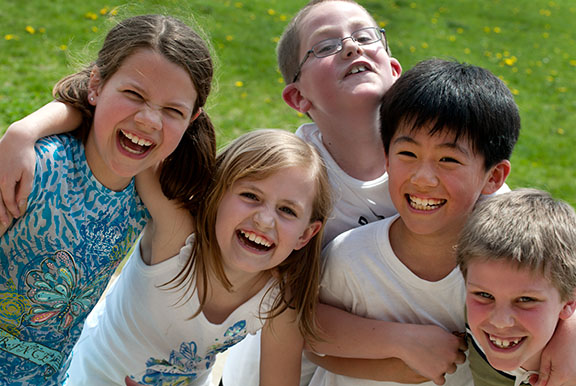
5) Lyapi
Leading is selected. The guys scatter while he counts to 10. After that, he catches them. Caught stops, also counts to 10 and starts to catch children. The previous leader also runs away from him.
Possible game on the "breeding". That is, if the leader slapped the player, then they are galyat together. A player who is not caught is considered a winner. The one caught first becomes the leader in the next game.

6) Bouncers
Two children (chosen by the reader or voluntarily) stand on both sides of the site, the distance from one to the other depends on the width of the site or simply on the mood. "Knock out" stand in the center. The task of knocking out: throwing the ball, get them into knocking out players. Those, in turn, should try to dodge. The player who was kicked out of the game (moves away to the side). But his comrades can “save” him if they manage to catch the ball in their hands. You can catch the ball only on the fly, in any case not from the ground. Who caught the ball from the ground - is eliminated. If several people are knocked out, the player who caught the ball chooses the one who should return to the game. When there is only one player left in the “knocked out” team, he must dodge the ball as many times as he is. In case of success, his entire team returns to the game, otherwise the teams switch places.
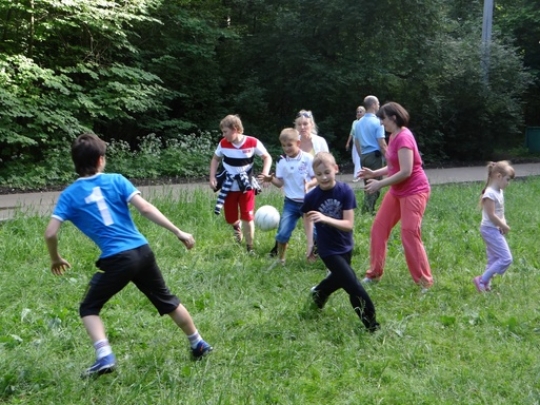
7) Hot Potatoes
All players stand in a circle and throw a ball to each other, beating it off. If one of the players has not hit the ball, he squats in the center of the circle ("cauldron"). The game continues. Any player at will can help out the "guilty". For this he, beating off the ball, tries to get them on those sitting in the center of the circle. “Exempt” (the one touched by the ball) takes part in the game again. Those sitting inside the circle try to catch the ball flying past. It is important - in this case you can not get up from the squat in full growth, you can only try to jump, not getting up in full growth. If any of the players succeeded, then all the "punished" come back into the game, and the player who threw the ball takes their place.
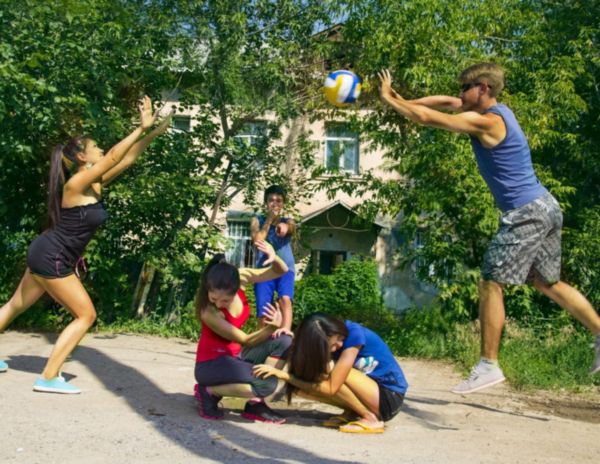
8) Edible - inedible
All players sit on the bench in a row (as an option - they become a circle). Lead throws the ball to any player and at the same time names an item. If "this" is edible - the player must catch the ball. If inedible - discourage him. If someone "ate" inedible, he became the leader.
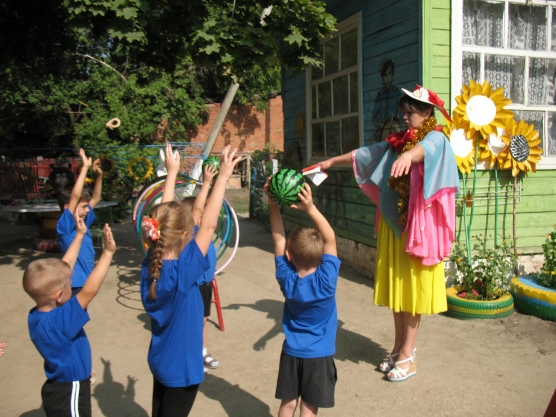
9) Brook
The number of players must be odd: everyone breaks up into pairs and stands next to each other, joining hands in pairs in high pairs. The driver enters the educated corridor from behind, chooses a pair of players for himself and gets up at the beginning of the “trickle”. The released player becomes leading, goes to the end of the “corridor”, passes through it and chooses a pair for himself.

10) Chains forged
Players are divided into two teams. Becoming in rows, holding hands, opposite each other (at a distance of about 10-15 meters).
One team shouts in chorus: "Chains are forged, share us!"
The team on the contrary asks: "Who among us?"
"Hidden" call the name of the player from the opposing team. The chosen one was trying to break the living chain with a run (it is important to choose the "right place", which seems to be the "weak link"). If you manage to break the chain - the player returns to his team, and takes with him one of the two "disengaged" comrades. If not - the player became a team just between the "links" that he tried to break.
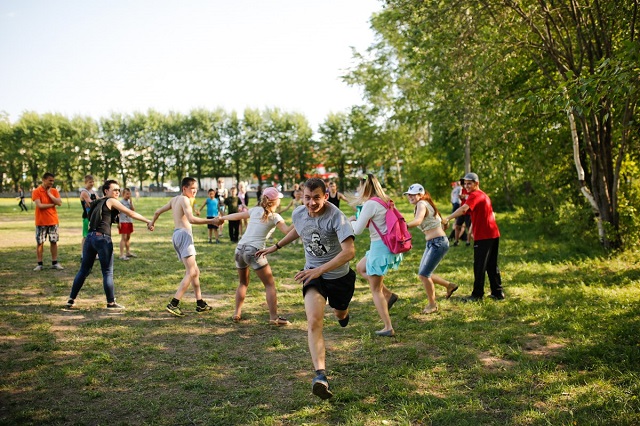
11) Go quietly - you will continue
All players stand on one side of the road, leading on the other side, and turn their backs to all. Leading says: "Slowly you go, you will continue. Stop!" The phrase can be pronounced as you please - deliberately delaying the words, the whole sentence, or, for example, starting slowly and then ending it quickly and quickly - in general, introduce an element of surprise into the game. At this time, all players are trying to run as far as possible, to go to the finish line, on the word "stop" freeze. After the word STOP the driver turns around. If he saw the movement of a player (who did not have time to stand still, or stop because of the speed of acceleration), he is out of the game. The winner is the one who first gets to the finish line and touches the driver - he takes his place, and the game starts over.

12) Squirrels - dogs
One player is chosen - "dog" (counting or voting). Then all the players are in a circle, and begin to throw the ball to each other. The task of the “doggie” is to catch the ball (to intercept it on the fly), for which you have to work hard, run a lot and jump. As a result, when the "dog" caught the ball, she has the right to stand in a circle with the players, and her place is taken by the player who caused the ball to be missed (the one who "incorrectly" threw it or the one who did not catch it).
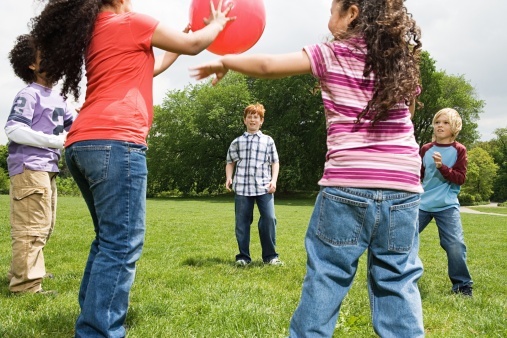
13) Olympiad
Two players of one team are at a distance of about 2 meters from each other, with rubber in hand. Further, without letting the gum out of their hands, they utter the "indecent" adage: "O-li-mpi-a-da - mother's lipstick - father's glasses - stop worms." At the same time constantly moving, tangling gum. You can step on it, twist it, change places - the main thing is to confuse as much as possible. Hands can not be moved, where they took a rubber - there and hold. On the word "worms", the players freeze, and as a result we get a "gossamer" of rezinochki. The task of the players of the second team is to move one by one to the other side of the “cobweb”, without touching it. As a rule, to get over, you need to crawl into a small triangle or square, you could crawl along the ground or even jump over the “construction”. In a sophisticated version of the game, it was required that each player prolazil into "his own" hole, and not repeat the "move" of another player. When everyone moved and did not touch - the game begins again. If someone hooked a rubber band, players change places.
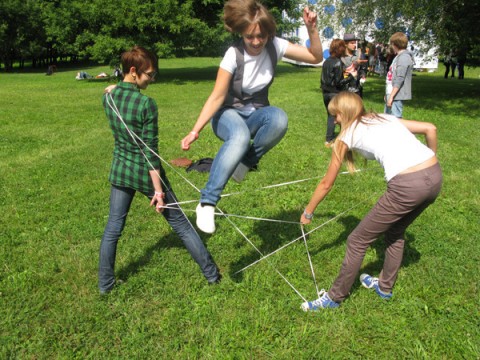
14) The sea is worried once!
Leading is selected. He turns away from the others and says a count (as he speaks, all players move erratically)
The sea is worried once
The sea is worried two
The sea worries three,
Sea figure on the spot freeze
Players freeze, depicting "sea" figures. The leader approaches any player, touches him with his hand - the player depicts who he is showing. The task of the presenter is to guess what kind of figure it is. If the player portrays the unlikely one, he becomes water to the next stage.
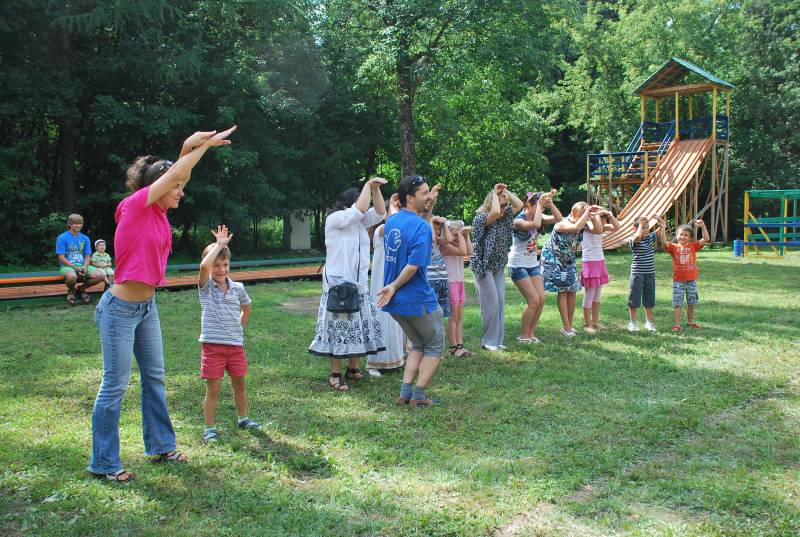
15) Deaf phone
The first (he is the presenter) whispers in the ear, sitting next to the player, any word (anything you want is enough). The second also (in a whisper and ear) transmits the word to the third, and so on - to the end. The last player gets up and calls out loud what he heard.
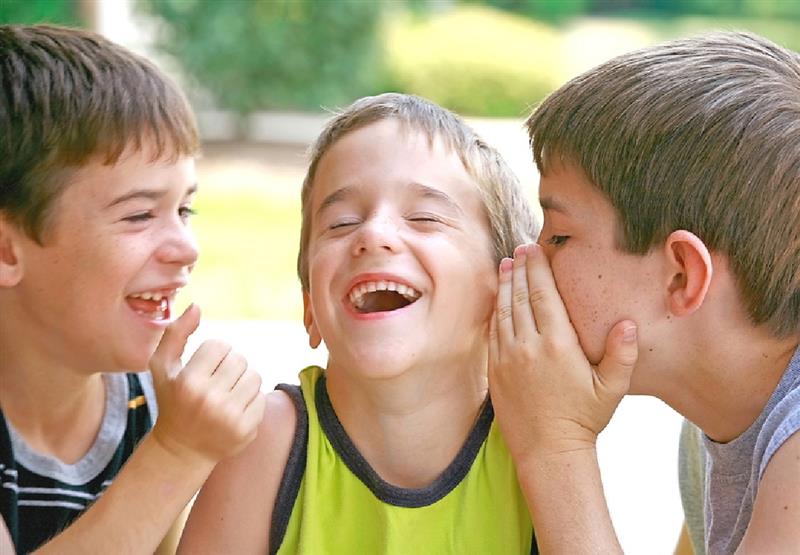
16) Horses

All players are divided into triples - it's a coachman and two horses. The driver gives the horses different commands, and the driver manages and monitors their implementation. You can ask them to run fast, in a circle, and so on. When the leader gives the command “Run wherever you want!”, The driver releases the reins, and the horses quickly run around the playground. At the command “Return to the coachman!” They should quickly find their manager. In each new round of the game, the coachmen should be changed. If the coachman’s horses are wrong, the whole company is fined. The role of the lead is best to choose an adult who will be easier to make tasks for players, horses. In the end, so that all the players come together, you can give the command: "Horses, return to the coachman!". It is desirable to play in three approaches, so that all participants can be a coachman. As a result, you can reward the top three.
And also: classics, rezinochki, kozaki-robbers - loved by us from childhood ... There are many outdoor games - and not only children, but also adults will play with pleasure and pleasure. And what could be better in the summer than outdoor activities with friends or family? So go ahead!


